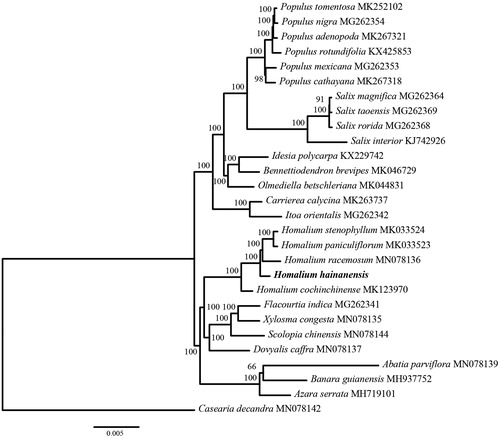Abstract
Homalium hainanense is a large evergreen tree species belonging to Salicaceae family, and its wood is tough, fine-grained, which makes it a good source of commercial use for building construction and furniture manufacturing. In this study, we sequenced the complete chloroplast genome of H. hainanense based on next generation sequencing and used these data to assess genomic resources. The size of the H. hainanense chloroplast genome was 157,852 bp, including a large single-copy region (85,888 bp), a small single-copy region (16,592 bp), and a pair of inverted repeats regions (27,686 bp). The overall GC content of the H. hainanense chloroplast genome was 36.6%. The plastome of H. hainanense was predicted to contain 112 unique genes, including 78 protein coding genes, 30 tRNA genes and 4 rRNA genes. The reconstructed phylogeny revealed that Homalium was monophyletic and H. hainanense was sister to H. stenophyllum, H. paniculiflorum and H. racemosum.
Homalium hainanense, a large tree which grows up to 30 meters tall, is a valuable tropical timber species belonging to Salicaceae family, and it was cultivated as an ornamental tree in southern China due to its excellent crown shape. In recent decades, deforestation has led to a dramatic decline in the population of H. hainanense. In this study, we sequenced and analyzed the chloroplast genome of H. hainanense based on the next-generation sequencing method (Dong et al. Citation2018). The objectives of this study were to establish and characterize the organization of the complete chloroplast genome of H. hainanense and retrieve valuable genomic resources for this species.
Fresh young leaves of H. hainanense were collected from a tree in Ledong, Hainan island (108°54′41″E, 18°41′02″N). The voucher specimen (Specimen accession number: RITF-LXJ2019) was deposited at the herbarium of Research Institute of Tropical Forestry, Chinese Academy of Forestry. Total genomic DNA was extracted using mCTAB protocol (Li et al. Citation2013). The DNA from silica dried tissue was fragmented to construct 350 bp insert library following the manufacturer’s manual (Illumina Inc., San Diego, CA, USA). The library was sequenced on the Illumina HiSeq X-ten platform at Novogene. Approximately 4 Gb data were generated from the sequencing library. The chloroplast genome was assembled with GetOrganelle (Jin et al. Citation2019). Plastomes were annotated with Plann (Huang and Cronk Citation2015). The sequence of H. hainanense complete chloroplast genome was submitted to GenBank, assigned with the accession number of MT478108.
The complete chloroplast genome of H. hainanense is 157,852 bp in length, and possesses the typical quadripartite structure including a LSC with the length of 85,888 bp separated from the 16,592 bp long SSC region by a pair of inverted repeats (IRs), each 27,686 bp. The plastome of H. hainanense was predicted to contain 112 unique genes, including 78 protein coding genes, 30 tRNA genes and 4 rRNA genes, respectively. Seventeen genes contain introns: 15 of them exhibit one intron and two of them contain two introns (clpP, and ycf3).
To estimate phylogenetic relationships of H. hainanense with other Salicaceae species. Phylogenetic analysis was conducted using published chloroplast genomes, including 27 species from Salicaceae. The chloroplast genome sequences were aligned using MAFFT v7 (Katoh and Standley Citation2013). Ambiguous alignment regions were trimmed by Gblocks 0.91 b (Castresana Citation2002). The maximum likelihood (ML) analyses were performed in RAxML v.8.1.24 (Stamatakis Citation2014) with branch support assessed by fast bootstrap using non-parametric bootstrap and 1000 ML pseudo-replicates. The reconstructed phylogeny revealed that Homalium was monophyletic and H. hainanense was sister to H. stenophyllum, H. paniculiflorum and H. racemosum (). The genome information reported here will be useful for marker development, species discrimination, and the inference of phylogenetic relationships in the genus Homalium.
Disclosure statement
No potential conflict of interest was reported by the authors.
Data availability statement
The chloroplast genome sequence of the H. hainanense was submitted to GenBank of NCBI (https://www.ncbi.nlm.nih.gov). The accession number from GenBank is MT478108.
Additional information
Funding
References
- Castresana J. 2002. GBLOCKS: selection of conserved blocks from multiple alignments for their use in phylogenetic analysis. EMBL.
- Dong W, Xu C, Wu P, Cheng T, Yu J, Zhou S, Hong D-Y. 2018. Resolving the systematic positions of enigmatic taxa: Manipulating the chloroplast genome data of Saxifragales. Mol Phylogenet Evol. 126:321–330.
- Huang DI, Cronk Q. 2015. Plann: A command-line application for annotating plastome sequences. Appl Plant Sci. 3(8):1500026.
- Jin J-J, Yu W-B, Yang J-B, Song Y, dePamphilis CW, Yi T-S, Li D-Z. 2019. GetOrganelle: a fast and versatile toolkit for accurate de novo assembly of organelle genomes. bioRxiv:256479.
- Katoh K, Standley DM. 2013. MAFFT multiple sequence alignment software version 7: improvements in performance and usability. Mol Biol Evol. 30(4):772–780.
- Li J, Wang S, Jing Y, Wang L, Zhou S. 2013. A modified CTAB protocol for plant DNA extraction. Chin Bull Bot. 48(1):72–78.
- Stamatakis A. 2014. RAxML version 8: a tool for phylogenetic analysis and post-analysis of large phylogenies. Bioinformatics. 30(9):1312–1313.

